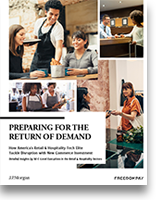The reduction in customer engagement, sales volume and value during the pandemic is making brands rethink habitual and outdated approaches to loyalty.
Merchants are changing their tech-investment conversation from ‘staying ahead of the dominant competitor’ to ‘staying up to speed with the rapidly shifting needs of customers and staff.’ But according to a new report from J.P. Morgan and FreedomPay, this has left one in five (19%) facing dilemmas about their immediate service priorities.
The 2020 pandemic took almost every business in every sector by surprise – both for its ferocity and speed at which the virus spread. For retail and hospitality businesses, it created a backdrop of shattered forecasts, crippling logistics and stymied sales.
by Molly A. Walsh
While ecommerce and curbside services boomed, merchants who rely on physical channels and services struggled to retain customer relationships, as throughput, face-to-face interactions and sales fell. Their focus flipped from staying one step ahead of the competition, playing ‘catch-up’ and ‘me-too’ with innovation, to rebuilding their customer base and accelerating demand.
The pandemic shocked reluctant tech-investors out of complacency
The report showed that in the past 12 months, almost half (44%) of America’s leading retail and hospitality merchants switched their efforts directly to better understanding the customer. Prior to the pandemic, the marketing focus was on finding and targeting the most lucrative audiences. During the pandemic, this shifted to keeping the customer base they worked so hard to build.
This has meant finding new methods of customer engagement, using technology to reduce physical ‘touchpoints’ to help shoppers and guests feel safe through touchless payments, self-ordering and check-ins, and secure e-commerce. As a result, we’ve seen the huge rise of contactless and mobile payments and the widespread adoption of QR codes to facilitate easier touch-free mobile ordering and check-in.
Underpinning this is the recognition that better use of ‘big data’ – and real-time insight – is now vital to maintain operations, respond to rapid change and support growth.
Using data to getting closer
Leaders, even before the pandemic, were hungry for new insight to help them identify trends and anticipate needs. This includes determining customer/guest behavior to optimize loyalty, offers and customer preferences or boosting efficiency through real-time analysis and stock control.
However, while 44% of retail and hospitality leaders perceive the value of their data has become more important, a high proportion (25%) feel that their current use of data is ineffective. There is clearly still much work to be done, even in the largest of organizations with the biggest of tech budgets.
A big challenge for both retail and hospitality is how to use digital downstream data to support bricks and mortar customer touchpoints. The pandemic highlighted that too many silos exist across channels and functions. These prevent businesses from having a 360-degree view of their customers, reducing their ability to interact and respond effectively to them.
There is no doubt that the pandemic has shone the spotlight on inherent gaps in customer relationships and service, and intensified demand for better ways to capture and use data in real time to allow a faster response to fluctuating conditions, behaviors, and trends.
Balancing data and ethics
Tech is enhancing the customer journey online and off. From in-venue sensors and geolocation trackers to AI and virtual reality, mobile apps and push notifications. All of these deliver speed and relevance right at the moment of engagement. But they can also turn customers off and create concerns around data protection and security.
Retail and hospitality organizations tread a fine line between customer empowerment and customer intrusion. On one hand, meeting customer expectation for hyper-personalization and on the other, safeguarding data, respecting privacy, and staying compliant.
And the bigger the customer’s digital footprint, the more opportunity there is for gathering and analyzing metadata. This has seen the industry swamped with new start-up retail and hospitality-tech businesses that focus on customer analytics and optimization.
But while they are hungry for more of the ‘right’ customer data, most organizations are not prepared to go beyond what they understand as ethical. There are undoubtedly opportunities to ‘game play the system’– especially when it comes to sharing pockets of data within Groups and across multiple locations. However, businesses are well aware that this can potentially backfire, and the resulting social and media backlash can compromise their continuing relationship with customers.
The pandemic is reshaping loyalty
Brand allegiance is no longer a given and must evolve in line with new behaviors, attitudes, and ethical considerations. The reduction in customer engagement, sales volume and value during the pandemic is making brands rethink habitual and outdated approaches to loyalty.
Retail and hospitality organizations are looking for new ways to bring customer loyalty into every interaction. Not simply asking customers to sign up to a static loyalty or referral program but loading it with more targeted and personalized incentives and doing whatever it takes to ensure both short and long-term customer retention.
The use of encryption and tokens to aid compliance is providing them with the tools to recognize and track individual customer journeys and enable loyalty value to be transportable across brands, locations, channels and even between other synergistic retail and hospitality partners.
Customer engagement, interaction and transaction must evolve.
Customer-centric organizations will have to renew their focus on digitalization, mobilization and greater unification and sharing. At the heart of this will be real-time, data-driven commerce.
Not only will this drive faster and more convenient payments, and increasingly compelling loyalty and easier-to-redeem rewards, but it also provides the rich data needed to predict trends, target customers, optimize pricing and customer service to elevate sales revenue and growth.
With pent-up demand poised to kick-start growth, it’s clear that those businesses which focus their tech investment on customers will hold the winning hand.
 To read the full J.P. Morgan & FreedomPay survey report: PREPARING FOR THE RETURN OF DEMAND –
To read the full J.P. Morgan & FreedomPay survey report: PREPARING FOR THE RETURN OF DEMAND –
How America’s Retail & Hospitality elite are fighting disruption with new commerce investment
 Molly A. Walsh is Managing Director, Integrated Payments Product Co-Head at J.P. Morgan
Molly A. Walsh is Managing Director, Integrated Payments Product Co-Head at J.P. Morgan
Photo by Klim Musalimov on Unsplash












